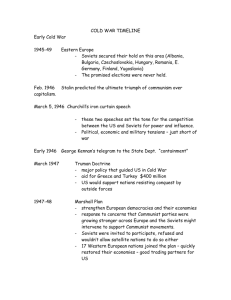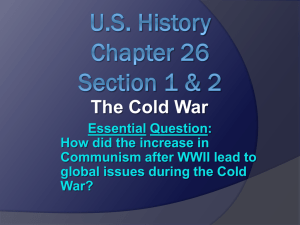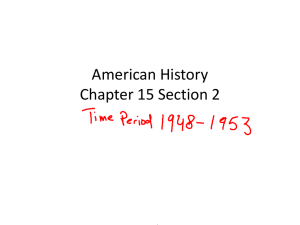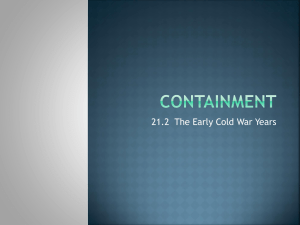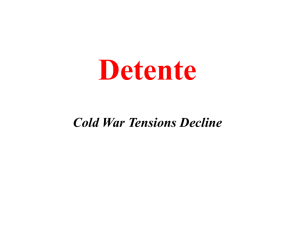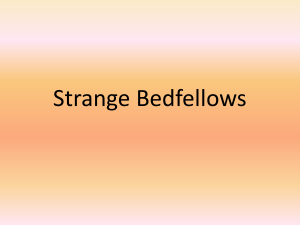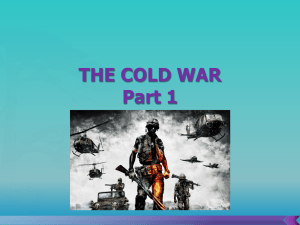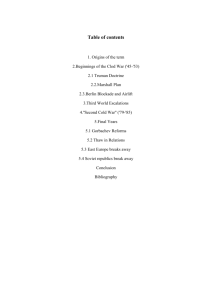File
advertisement
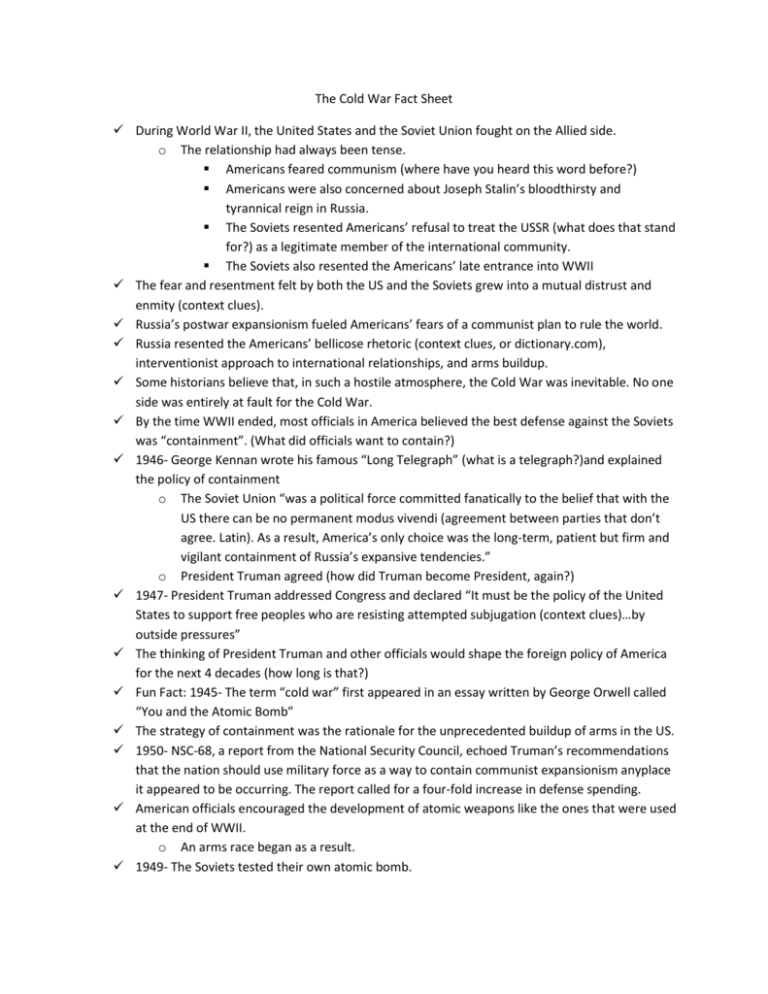
The Cold War Fact Sheet During World War II, the United States and the Soviet Union fought on the Allied side. o The relationship had always been tense. Americans feared communism (where have you heard this word before?) Americans were also concerned about Joseph Stalin’s bloodthirsty and tyrannical reign in Russia. The Soviets resented Americans’ refusal to treat the USSR (what does that stand for?) as a legitimate member of the international community. The Soviets also resented the Americans’ late entrance into WWII The fear and resentment felt by both the US and the Soviets grew into a mutual distrust and enmity (context clues). Russia’s postwar expansionism fueled Americans’ fears of a communist plan to rule the world. Russia resented the Americans’ bellicose rhetoric (context clues, or dictionary.com), interventionist approach to international relationships, and arms buildup. Some historians believe that, in such a hostile atmosphere, the Cold War was inevitable. No one side was entirely at fault for the Cold War. By the time WWII ended, most officials in America believed the best defense against the Soviets was “containment”. (What did officials want to contain?) 1946- George Kennan wrote his famous “Long Telegraph” (what is a telegraph?)and explained the policy of containment o The Soviet Union “was a political force committed fanatically to the belief that with the US there can be no permanent modus vivendi (agreement between parties that don’t agree. Latin). As a result, America’s only choice was the long-term, patient but firm and vigilant containment of Russia’s expansive tendencies.” o President Truman agreed (how did Truman become President, again?) 1947- President Truman addressed Congress and declared “It must be the policy of the United States to support free peoples who are resisting attempted subjugation (context clues)…by outside pressures” The thinking of President Truman and other officials would shape the foreign policy of America for the next 4 decades (how long is that?) Fun Fact: 1945- The term “cold war” first appeared in an essay written by George Orwell called “You and the Atomic Bomb” The strategy of containment was the rationale for the unprecedented buildup of arms in the US. 1950- NSC-68, a report from the National Security Council, echoed Truman’s recommendations that the nation should use military force as a way to contain communist expansionism anyplace it appeared to be occurring. The report called for a four-fold increase in defense spending. American officials encouraged the development of atomic weapons like the ones that were used at the end of WWII. o An arms race began as a result. 1949- The Soviets tested their own atomic bomb. o Truman declared that the US would build even more destructive weapons, like the hydrogen bomb. o Stalin built his own “super bombs” The stakes during the Cold War were very high as a result of the arms race. o The first test of a hydrogen bomb, H-bomb, was at the Eniwetok Atoll in the Marshall Islands. The bomb blast created a 25 square mile fireball, which vaporized an island. A huge hole was blown in the ocean floor. The bomb had the power to destroy half of Manhattan. o The testing of all the nuclear bombs spewed poisonous radioactive waste into the atmosphere. With the threat of nuclear annihilation, American domestic life was impacted as well. o Ordinary people built bomb shelters in their back yards. o There were attack drills practiced in schools and other public places. o Moviegoers in the 1950’s and 1960’s were horrified with depictions of the devastation of nuclear attack and mutant creatures. o The Cold War had a constant presence in the everyday life of every American. October 4, 1957- The Soviets launched an R-7 intercontinental ballistic missile, Sputnik. (What does Sputnik mean in Russian? You can Google this.) This was the first artificial satellite and man-made object placed in Earth’s orbit. o The launch came as a surprise to most of the country. Space was seen as the next frontier to most Americans. It was a logical extension of the American tradition of exploration. This made it crucial to not lose too much ground to the Soviets. o The launch also made it necessary to gather as much information as possible about the Soviets’ military activities. 1958- The US launched Explorer 1, which was designed by the US army under the direction of rocket scientist Wernher von Braun, a German scientist and Nazi during WWII.***Why would the US employ a former Nazi as a scientist? (#3) o The Space Race began the day that Explorer 1 was launched. o President Dwight Eisenhower signed the public order that created the National Aeronautics and Space Administration (NASA). This was a federal agency dedicated to exploring space. NASA was also charged with exploiting the military potentials of space. April, 1961- The Soviets launched the first man into space. Staying 1 step ahead. May, 1961- Alan Shepard became the first American in space. President Kennedy made the statement that the US would have a man on the moon by the end of the decade. July 20, 1969- Neil Armstrong became the first man to step foot on the moon. Armstrong was a part of NASA’s Apollo 11 mission. o American astronauts would come to be seen as the ultimate American heroes. The people on the ground enjoyed living vicariously (context clues) through them o In turn, the Soviets were seen as the ultimate villains. Their relentless and massive efforts to surpass America to prove the power of communism. The House Un-American Activities Committee (HUAC) brought the Cold War home to the general public in a different way. o Beginning in 1947, the committee began a series of hearings. These hearings were designed to show that communist subversion was alive and well in the US. o The HUAC forced hundreds of people in the movie industry in Hollywood to renounce left-wing beliefs, as well as testify against each other. More than 500 people lost their jobs as a result of the hearings. Still others were blacklisted and could not work for more than a decade. o The HUAC also accused State Department employees of engaging in subversive activities. o Senator Joseph McCarthy expanded this probe to include anyone who worked for the federal government. Thousands of federal employees were investigated and fired. They could be prosecuted as well. o As the anti-communist hysteria spread throughout the 1950’s, college professors with liberal views lost their jobs, people were asked to testify against friends and co-workers, and people swore loyalty oaths all the time. June, 1950- The first military action of the Cold War began. The North Korean People’s Army, backed by the Soviets, invaded the Pro-Western South. o American officials saw this as the first step in the communist plot to take over the world. Nonintervention was not an option. Truman sent troops to Korea. The war dragged to a stalemate. It ended in 1953. Early 1960’s- President Kennedy faced several troubling situations in the Western Hemisphere. 1961- The Bay of Pigs invasion. 1962- The Cuban Missile Crisis. These two events proved that communism was a real threat in the post-colonial Third World. o This was most apparent in Vietnam. The French colonial regime collapsed and led to a struggle between the American backed Ngo Dinh Diem, a nationalist, in the south and the communist Ho Chi Minh in the north. The US had been committed to an anticommunist government surviving in the region. By the early 1960’s, they had figured out that for containment to happen, they would have to be more active in intervening on Diem’s behalf. The war in Vietnam was intended to be a brief conflict and turned into a 10-year conflict. As soon as Richard Nixon took office, he took a new approach to international relations. o He suggested using diplomacy instead of military action to create more poles in a hostile, bi-polar world. o He encouraged the United Nations to recognize the Chinese government (a communist state). He visited China in 1972, and began to establish diplomatic relations with Beijing (why would Nixon deal with people in Beijing?) o He adopted the policy of “détente”, or relaxation, toward the Soviets 1972- Nixon signed SALT (Strategic Arms Limitation Treaty) with Soviet Premier Leonid Brezhev o SALT prohibited making nuclear weapons on both sides of the Cold War o SALT also took a step toward reducing the threat of nuclear war that had existed for decades The Cold War heated up again under President Ronald Reagan, despite Nixon’s efforts. o Reagan believed, like many of his generation, that the spread of communism in one place threatened people everywhere. Reagan worked to provide military and monetary aid to anticommunist governments and insurgents around the world. This policy was known as the Reagan Doctrine Even as Reagan was fighting communism in Central America, the Soviet Union itself was breaking up. o Severe economic problems and growing political unrest greeted Premier Mikhail Gorbachev when he took office in 1985. He introduced t2 policies that redefined Russia’s relationship with the rest of the world Glasnost, political openness Perestroika, economic reform Soviet influence in the Eastern Europe region waned 1989- Every communist government in Eastern Europe was replaced with a noncommunist one. November, 1989- The Berlin Wall, a visible symbol of the Cold War, was finally destroyed. o Just over two years before, Reagan had made a speech at the Brandenburg Gate challenging Premier Gorbachev: “Mr. Gorbachev, tear down this wall.” 1991- By this time the Soviet Union itself was gone. The Cold War was over. The Cold War Fact Sheet Questions 1.) When did the Cold War start? a. 1946 b. 1846 c. 1746 d. 2046 2.) Who was involved in the Cold War? a. Great Britain, France b. The US, Russia c. The US, Germany d. Germany, Great Britain 3.) Find the *** in the fact sheet. Write your answer here. ______________________________________________________________________________ ______________________________________________________________________________ ______________________________________________________________________________ ______________________________________________________________________________ 4.) What is the difference between a Cold War and a Hot War? ______________________________________________________________________________ ______________________________________________________________________________ ______________________________________________________________________________ ______________________________________________________________________________ 5.) Who wrote the Long Telegraph of 1946? a. George H.W. Bush b. George Washington c. George Kennan d. George W. Bush 6.) When did the Space Race begin? What started it? ______________________________________________________________________________ ______________________________________________________________________________ ______________________________________________________________________________ ______________________________________________________________________________ 7.) President Kennedy made the statement that the US would be on the moon by the end of the 1960’s. The US sent Apollo 11 to the moon on July 20, 1969. True or False 8.) When did the Cold War finally end? a. 1891 b. 2001 c. 1961 d. 1991 9.) Where was President Reagan when he challenged “Mr. Gorbachev, tear down this wall.”? a. The Brandenburg Gate, Berlin b. The White House, Washington, D.C. c. His house, California d. The moon

